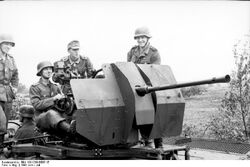The FlaK 30 was an anti-aircraft artillery piece used by Germany during World War II.
Description[]
The FlaK 30 fired 20 mm rounds and the highest a round could go was about 3,668.5 meters. The FlaK 30 was also fed by a 20 round magazine which weighed about 9.5 kg full.[1] The maximum range was about 2,000 meters and it usually required 7 men to operate. The cyclic rate of fire was 280 rounds per minute while the average was 120 rounds per minute. The FlaK 30 could traverse a full 360 degrees and the elevation ranged from -12 degrees to +90 degrees.
The total weight of the FlaK 30 system was 450 kilograms in its deployed state and 770 kilograms in its travel state. The total length was four meters. There were different types of ammunition that could be used by the FlaK 30, but often explosive rounds or tracer armor-piercing rounds were used.[2] In order to travel, the FlaK 30 had two deployable wheels. The reliability of the weapon system suffered often, in the field the gun was prone to jamming. Also, by 1941, the gun was too slow to deal with most enemy aircraft.
Variants[]
- FlaK 30: The standard 450 kg version with the average rate of fire of 120 rounds per minute.
- FlaK 38: An upgraded variant that was introduced in 1940.[3] The FlaK 38 had an increased average rate of fire of 220 rounds per minute.
- GebirgsFlak 38: An air transport-friendly, harsh condition variant with a modified mount for uneven and rough surfaces. Mainly issued to Fallshirmjäger and Gebirgsjäger units.[4][5]
- Flakvierling 38: A quad-mount for the FlaK 38.[6]
History[]

A German Flak crew operating in the Soviet Union, 1943.
The FlaK 30 was first developed in 1934 as Germany's new anti-aircraft cannon as part of its newly formed armed forces. The FlaK 30 and its variants were used in many different areas of the Wehrmacht, including on warships (where it saw a good amount of success), half-tracks, etc. The FlaK 30 was used in many different areas of the war like the Eastern Front and the Western Front. FlaK 30s were produced by both Mauser and Rheinmetall-Borsig and in total, over 140,000 were produced in World War II.
References[]
- ↑ http://www.militaryfactory.com/armor/detail.asp?armor_id=441
- ↑ http://www.tarrif.net/wwii/guides/flak30_38.htm
- ↑ http://www.lonesentry.com/ordnance/2-cm-flak-38-a-a-a-t-gun.html
- ↑ http://www.lonesentry.com/ordnance/tag/flak-38
- ↑ http://www.lonesentry.com/ordnance/2-cm-flak-38-geb-a-a-a-t-mountain-gun.html
- ↑ Lüdeke, Alexander. Weapons of World War II. Parragon Books Ltd. (2007), Page 148
| ||||||||||||||||||||||||||||||||||||||||||||||||||
